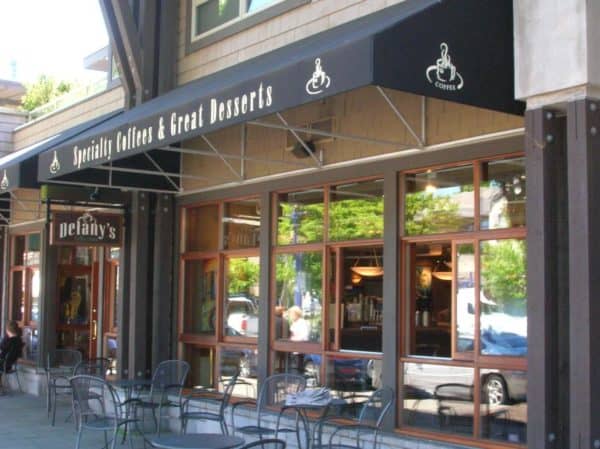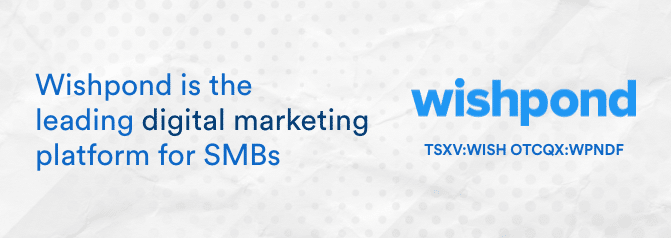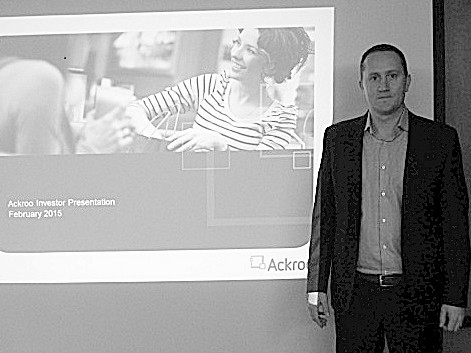Tyler Nelson is having trouble seeing.
“I was to be out of this eye doctor appointment twenty minutes ago,” he explains before rescheduling our interview. “She is doing another test not planned, sorry!” I respond that we can talk about his vision and then his corporate vision the same time the following day.
“Corporate vision is 20/20,” he chides.
Look at the progress Nelson and Ackroo co-founder Eamonn Garry have made in such a short time, and its hard to argue. The Canadian tech stalwarts have assembled a technical team that would be the envy of a company many times its size, and have plotted a shrewd strategy to tackle a market that could be worth billions to the winner.
Ackroo (TSXV:AKR) began with a rethinking of the digital electronic payment interchange platform, where Nelson and Garry looked to apply their considerable knowledge of the telecom sector’s changes to a space they felt wold undergo a similar evolution. The result is a solution that allows small and medium sized business to implement loyalty programs that can compete with national and international firms without breaking the bank. Cantech Letter’s Nick Waddell talked to Nelson about what’s next for Ackroo.
Tyler, can you tell us about the origins of Ackroo?
Eamonn Garry, my business partner, co-founder and current Ackroo CTO and COO, and I had spent three and a half years working at Bridgewater Systems together. I was just finishing up a successful exit on a company called Adenyo (sold for $100M in 2011) and we were looking to work together on a new project. We had spent a lot of time over the summer of 2011 talking about where in the technology marketplace we saw the next global-scale problems exist. We talked about where we felt there was the business opportunity to solve a problem and where we could apply our skills and background in the telecom space, but into a space that was more of an applied technology.
What did you decide on?
Well, we started by looking at the payment processing and loyalty space. As consumers, we shop, we buy, we swipe: there’s a debit and credit machine at the cash, we swipe our bank or credit card and we usually don’t give it a second thought. On the other side of the counter – for the merchant – there is complex series of hardware and software supporting these transactions through an ecosystem of merchant payment processors, merchant service providers (MSPs) and suppliers and vendors. For both bricks and mortar and online businesses, it’s this combination of hardware and software that merchants use to process these payment transactions.
Where does loyalty fit in?
The infrastructure is the backend of the business. At the front of the business, merchants worry about attracting and retaining customers. And as a consumer, what is going to make you shop at one grocery store over another; go to this coffee shop instead of that coffee shop. Over and above perhaps service, convenience or price it’s the ‘what’s in it for me’ factor. What added value am I getting for shopping at this particular retailer? What added value am I getting that will entice me back again and engender my loyalty to that merchant? We saw the success that big players were realizing in the loyalty space. We saw the uptake of custom loyalty programs like Starbucks and Shoppers Optimum and loyalty currencies like Air Miles and Aeroplan. There are plenty of large companies successfully servicing that market of national chains and retailers.
It seems like there are already a lot of loyalty solutions out there – what is Ackroo doing that’s different?
That’s just it. There are a lot of loyalty programs out there. Think about what you may have in your wallet right now – Esso Extra, Shoppers Optimum, Starbucks, AirMiles – it’s the national and international brands that have led the way in loyalty. These are big businesses with big budgets that know a loyalty program is one of the most powerful tools a retailer can use to increase customer volume and transactions to ultimately drive increased revenue. Any investor can look at the management discussion in the quarterly filings of Starbucks and see that they point to their loyalty and rewards programs as one of the single most important profit drivers of their business. But what we also know is more than half the North America retail market is made up of small to medium sized businesses. These smaller merchants and retailers spend their days worrying about inventory and staff showing up for work, trying to bring more customers through the door, and trying to bring them back more often. We know they need payment processing and there’s a demand for loyalty programs but the big loyalty providers can’t scale down to fit the needs of these small businesses. We also know these smaller merchants do not have the five and six, sometimes seven figure budgets, to launch a customized loyalty program of their own.

What did you come up with?
We blended all this information together and came to the conclusion that the right place to intercept this ecosystem was to start arming these small to medium sized merchants with a loyalty and rewards platform integrated with their existing point of sale terminals that could allow them to compete with their bigger competitors at a fraction of the cost. Then we brought it to the next level and saw that within this payment ecosystem there is a mandatory set of payment providers that dominate the market. With our backgrounds and understanding of the landscape of next generation and mobile solutions we knew that the success would be in the using these providers to piggyback on what they are already doing.
Infrastructure-wise, you are placing technology over top of an existing network…
Yes. But ultimately, to be successful in this space at scale, we decided to do a few basic things: don’t force change to consumer behavior and don’t force change to merchant behavior. No new cash register, no new payment terminal, no new iPad, no capital outlay to install new software. It has to be simple, simple, simple. In our business we want the lowest cost of activating a merchant, something approaching zero. If you have to sell them a new terminal, well that’s an expensive process with years of payback on your business model unless you can insert yourself in the natural upgrade cycle. We wanted to be able to capture a merchant and have them pay for themselves after the third or fourth month with us.
You believe that point of sale terminals aren’t going away?
Not only are they not going away, they are actually going through interesting life-cycle changes. You’ll notice a whole new generation of payment terminals popping up in retail right now. They have color screens, they have touch screens, they are starting to look more and more like a computer terminal or smartphone. These devices have more memory, more processing power, and they are starting to be able to support complex applications. They are not going away. Point of sale terminals are the primary means for payment transaction in bricks and mortar businesses but they will be going through a generational change over the course of the next two to five years and the line between traditional POS and mobile will blur. We’re right at the cusp of riding that wave of change.

In a way you are not being disruptive at all, you are working with existing consumer habits…
Exactly. We’re not out to change the way consumers are accustomed to dealing with merchants. We want to make it easy and adaptable to any consumer’s behaviour. These rewards cards that we all have in our wallets are very common. Statistics tell us that 75% of Canadians belong to some kind of consumer rewards program and we interact with these loyalty programs through plastic cards. While these plastic cards aren’t going away, we believe they will fragment. Most people still prefer them. Merchants like having their logo on a card, and handing out a tangible reminder of their loyalty and rewards programs and their brand.
You don’t think that Near Field Communications or proximity marketing is going to replace the experience of having a plastic card?
Again, it’s fragmenting. There are multiple methods in which a consumer can identify himself to a merchant – a plastic card, a telephone number, NFC, a mobile application. We recognize that the consumer needs to identify himself at the point of sale but the method of identification should be open and adaptable. We’ve set out to support these methods when the market and consumers are ready. Again, forcing change is counterproductive – a transaction needs to be easy for both the merchant and the consumer. Adoption of these new payment and identification methods is expanding and we will adapt to support them.
What are the challenges you are addressing, and do you have a sense of the size of the space?
In North America alone there are 450,000 small to medium sized merchants; those with less than fifty employees that deliver more than 53% of the entire North American retail economy of $4.5 trillion. It is certainly a market at scale in our own back yard. I would describe it as “haves” and “have-nots”. The “haves” are the 47% of retailers who service the rest of the marketplace; the national and international chains that have the marketing and technology budgets to spend millions or tens of millions a year to build, manage and market their loyalty and rewards programs to their customers. But what if you are local business with ten locations? What if you are an independent retailer selling groceries or coffee? How do you compete against Loblaws or Starbucks? That’s the opportunity. We are arming those merchants to go head-to-head with their competitors. Customer retention programs aren’t just for the big dogs anymore, says Ackroo.
Can you walk me through the experience for your customers?
Our customers are unique businesses – coffee chains, hair salons, car dealerships – and each comes with a unique set of business needs and goals. The great thing about Ackroo is that we can scale to meet the needs of any type of merchant from the single site mom-and-pop shop to larger multi-site independent merchants to franchises. We allow local coffee chains like Delany’s Coffee and Bean Around the World to compete with the Starbucks around the corner. We allow COBS Bread to run a national loyalty program at over 80 locations across Canada. The flexibility of our system allows each merchant to design the program that best fits their business – gift card program, loyalty program, or a combination of the two. We’re already integrated with their existing credit card machines or terminals, so merchants are up and running in a matter of days. And for those smaller businesses who may not have physical POS terminals, we have a virtual terminal solution. Everything is hosted in the cloud so there are no servers or new hardware to install onsite. Businesses can monitor their programs through an online portal where they can generate reports on business stats, consumer transactions, time of day traffic. It gives small businesses an economical way to offer a gift card and loyalty program that is as every bit as powerful as the bug guys’ – that ultimately drives repeat business and revenue back through their door.
Lately we’ve seen services and loyalty and reward offerings from companies like Square, AirMiles and Starbucks being offered to consumers. Square recently entered the Canadian market. How do you plan to compete against Square and these other players?
That’s a great question and speaks to the complexity and sometimes confusion around the payment ecosystem and its complimentary solutions. Square is a perfect example of a business that has found its niche serving small to medium sized businesses – but they are not a direct competitor of Ackroo. Square is among the new generation of payment processors offering merchants a new way to to accept and process credit card payments via a mobile application. It’s great for retailers who may want to compliment their existing point of sale processors or for very small businesses to be able accept credit cards or those who may not want to pay transaction fees of other credit card payment processors. Ackroo’s solutions can adapt to work with these new payment processors, but we do not compete with them. AirMiles and Aeroplan are examples of ‘loyalty currency’ programs: consumers carry an AirMiles card and can collect AirMiles points at various merchant locations. Those points can later be redeemed for goods and services through select AirMiles partners, they are not always redeemable at the merchant where the consumer earned the points. These ‘loyalty currency’ programs provide multiple locations and opportunities for consumers to collect points, but do little to promote the actual merchant issuing the points. Starbucks’ loyalty program, on the other hand, is a customized loyalty program designed specifically for that merchant – Starbucks loyalty program members can only collect and redeem Starbucks points at a Starbucks store. It’s the providers of this breed of loyalty program that are Ackroo’s solution competitors – but on a smaller scale and without the six figure price tag. Our advantage is that we are focused and agile enough to offer the small to medium sized merchant market the opportunity to compete with these international programs through an easy to use, web-based SaaS (software-as-a-service) platform.
Can you explain to our readers why SaaS is such a hot topic for investors right now?
I don’t believe SaaS is any more or less attractive now to tech investors than it was four, five or eight years ago. In the current economic climate, investors seeking early stage tech opportunities naturally focus on those business models that provide the most predictable and stable economic returns. Over time, it’s the certainty of recurring revenue that is both attractive and investable in a SaaS-based business model.
This goes again to the idea that you can scale this business without a huge capital outlay.
Exactly. I think a lot of entrepreneurs in this space make the mistake of wanting to be ‘the’ brand to the consumer. Ultimately, what you have to look for is the most efficient path to market. In this case it’s both the most cost efficient and is also aligned with the way merchants and consumers behave today. We are building an extremely compelling, quickly deployed, low-cost, high-value solution with optional and customizable features sets. We are not trying to be a brand like Aeroplan or AirMiles. We are bolting our solution onto an existing supply chain with an easy platform that allows merchants to be successful with their customers.
What do these partnerships with the players in this supply chain mean for your sales force, marketing and distribution efforts going forward?
Ackroo’s strategic thesis is built around constructive alignment with payment processors, essentially arming those who already have payment processing relationships and infrastructure with the Ackroo solution. We will leverage their sales force to drive the acquisition of customers at the lowest possible cost of acquisition. We will ensure that we integrate with existing supply chain management to keep merchant behavior and process the same. By partnering with Ackroo these payment processors benefit by providing a differentiated solution to their customers that can meet the small to medium sized merchant requirements from basic gift card programs through to more evolved and comprehensive loyalty and promotion capabilities. Commercially, the processors benefit through an increase in ‘entanglement’, or churn reduction, in their merchant base as merchants that deploy the Ackroo solution are much less likely to turn to another payment processing partner due to the adoption and success of the loyalty solution into their end customer base.
What metrics should investors and analysts use to measure the success in a business like Ackroo?
Our pricing model consists of a set up fee plus a monthly fee based on the number of merchant locations and the number of consumer transactions processed. So our success isn’t measured by the size or kind of customer, it’s measured by the number of customer locations we turn on. In January we turned on our 250th customer location – a great milestone so early in the new year. And while we’re not targeting large merchants like Starbucks or Walmart, we’ve already garnered interest from national chains and retailers who are looking for a comprehensive and affordable loyalty solution. As with other SaaS companies, as our business model matures the classic SaaS metrics such as monthly recurring revenue volume will increase.
I recently reviewed Ackroo’s public filings and noticed that a number of institutional investors including Fidelity and BMO. Some of your customers participated in your recent and previous funding rounds. Can you elaborate on this for our readers?
Yes, we are very fortunate to have a lot of great support from some of the leading institutions in Canada and a number of high profile investors and entrepreneurs who believed in us, our business model and our and approach to market. And yes, even some of our customers are investors. They’ve seen the benefits first hand of what Ackroo can do for their business. That really speaks volumes about the confidence our customers have in us.
What kind of milestones should investors be looking for from Ackroo in the next year?
We completed our initial listing on the TSX-V and funding in the fall of 2012. We were on the road immediately afterwards, talking to current and prospective investors. And while we continue to have a laser focus on the business, we feel it’s important to consistently meet and communicate with investors. A large part of our go-to-market strategy hinges on partnerships with channels; resellers of our solution. That’s our path to scale. I think the things that are important to watch for are partnerships with payment processors and merchant service providers that will sell our solution on our behalf as an ingredient of their platform, or as a stand-alone adjunct to their platform. Also look for introductions into new verticals and new markets. From these announcements, prospective and current investors can start to add up the merchants we are reaching, and ultimately this attachment rate will be an important indicator of our success. Another thing to watch for will be a series of technology enhancements throughout the year that will increase our total available market in the small to medium sized businesses in North America. These will include certifications on new payment terminals and additional integrations into existing merchant technologies and merchant management systems. It’s going to be an exciting year ahead for Ackroo.
Disclosure: Ackroo is an annual sponsor of Cantech Letter.
_____________________________
Leave a Reply
You must be logged in to post a comment.







 Share
Share Tweet
Tweet Share
Share




Comment